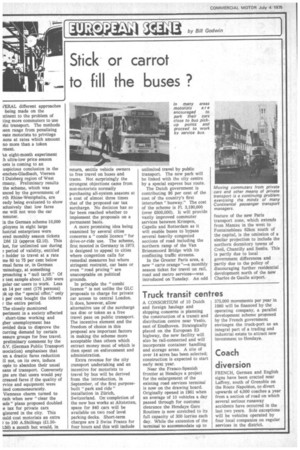Stick or carrot to fill the buses ?
Page 42

If you've noticed an error in this article please click here to report it so we can fix it.
return, entitle vehicle owners to free travel on buses and trams. Not surprisingly the strongest objections came from non-motorists normally purchasing all-system seasons at a cost of almost three times that of the proposed car tax surcharge. No decision has so far been reached whether to implement the proposals on a permanent basis.
A more promising idea being examined by several cities concerns a " combi licence " for drive-or-ride use. The scheme, first mooted in Germany in 1973 is designed to appeal to cities where congestion calls for remedial measures but where stringent restraint, car bans or even " road pricing" are unacceptable on political grounds.
In principle the " combi licence" is not unlike the GLC proposals to charge for private car access to central London. It does, however, allow alternative use of the surcharge tax disc or token as a free travel pass on public transport. The incentive element and the freedom of choice in this proposal are important factors in making the scheme more acceptable than others which extract money most of which is then spent on enforcement and administration.
Extra revenue for the city transport undertaking and an incentive for motorists to travel by bus will be derived from the introduction, in September, of the first purposebuilt "park and ride" installation in airich, Switzerland. On completion of the new bus works at Altstetten, space for 840 cars will be available on two roof level parking decks. Short-term charges are 2 Swiss Francs for four hours and this will include unlimited travel by public transport. The new park will be linked with the city centre by a special express bus route.
The Dutch government is contributing 95 per cent of the cost of the country's first interurban " busway." The cost of the scheme is Fl. 3,190,000 (over £600,000). It will provide vastly improved commuter services between Krimpen, Capelle and Rotterdam as it will enable buses to bypass several heavily congested sections of road including the northern ramp of the Van Brienenoord Bridge with its conflicting traffic streams.
In the Greater Paris area, a new "carte orange "—a monthly season ticket for travel on rail, road and metro services—was introduced on Tuesday. An odd
Moving commuters from private cars and other means of private transport is a continuing problem exercising the minds of many Continental passenger transport managers.
feature of the new Paris transport zone, which extends from Mantes in the west to Fontainebleau 62km south of the capital, is the omission of a similar projection to include the northern dormitory towns of Creil, Chantilly and Senlis. This is partly due to local government differenoes and partly due to the policy of discouraging further residential development north of the new Charles de Gaulle airport,




















































































